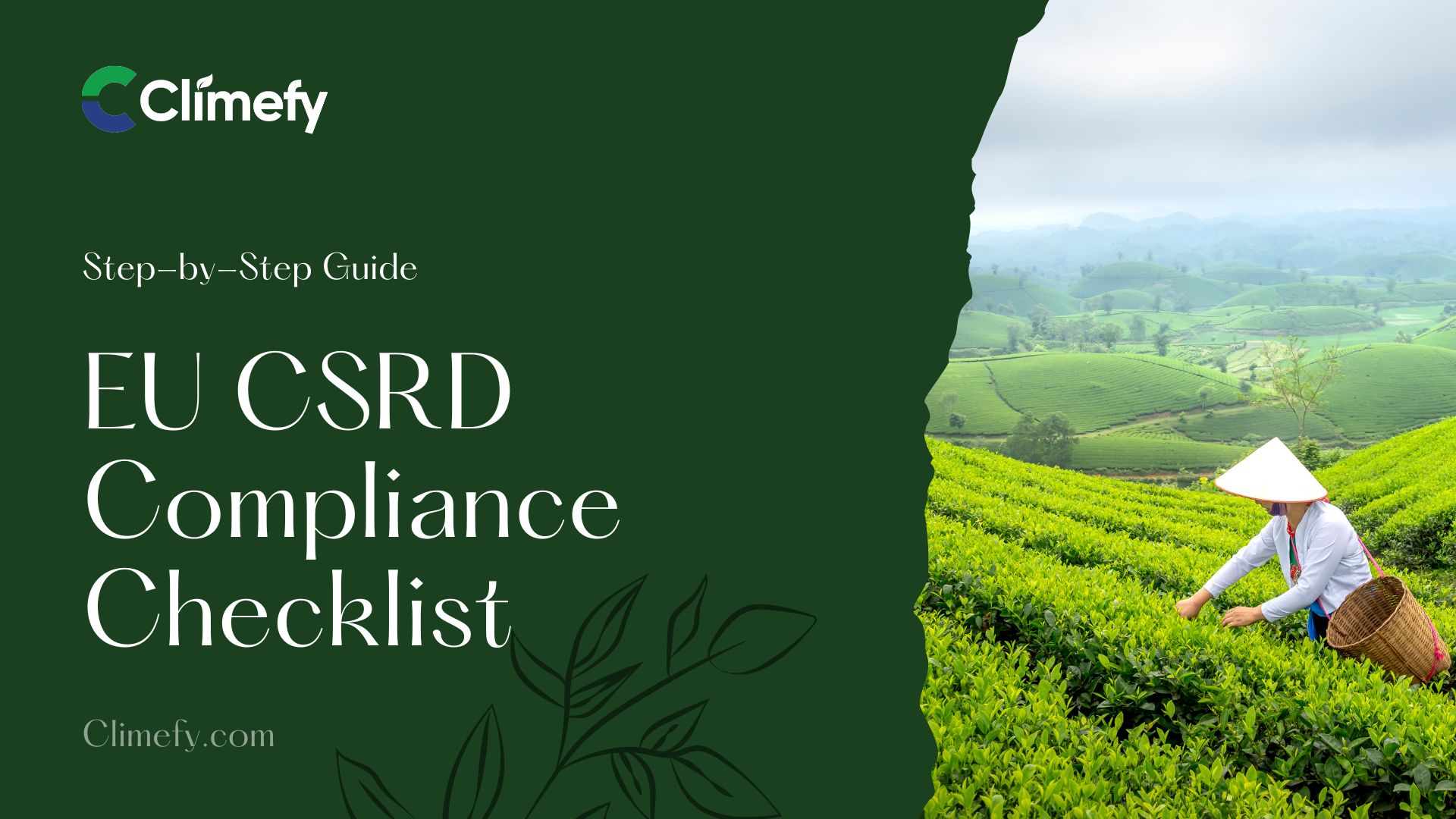

The EU Corporate Sustainability Reporting Directive (CSRD) is a transformative regulation driving businesses toward greater transparency in sustainability reporting. Effective from 2024, with full compliance expected by 2025, the CSRD mandates detailed disclosures on environmental, social, and governance (ESG) impacts. The following is a step-by-step checklist to ensure your organization meets CSRD requirements, optimizes sustainability strategies, and aligns with EU sustainability goals. From understanding key terms to implementing robust reporting frameworks, this article is your go-to resource for navigating the CSRD landscape.
Why This Guide Matters:
✅ Clarity on CSRD Scope: Defines which companies are required to comply and outlines key deadlines.
✅ Actionable Steps: Offers practical steps for ESG data collection, double materiality assessments, and compliance reporting.
✅ SEO-Optimized Insights: Incorporates semantic keywords for visibility on search engines and AI-driven platforms.
✅ Comprehensive Coverage: Addresses common queries, including “What is CSRD?” and “How to prepare for CSRD compliance in 2025?”

The EU Corporate Sustainability Reporting Directive (CSRD) is a landmark regulation under the EU’s Green Deal, replacing the Non-Financial Reporting Directive (NFRD). It mandates companies to report on sustainability impacts, risks, and opportunities in a standardized, transparent manner. By 2025, thousands of companies across the EU and beyond must comply, making it critical for businesses to align with its requirements. The CSRD aims to enhance accountability, support sustainable finance, and drive the transition to a low-carbon economy.
Key Facts About CSRD:
✅ Expanded Scope: Applies to large companies, listed SMEs, and non-EU companies with significant EU operations.
✅ Standardized Reporting: Uses European Sustainability Reporting Standards (ESRS) for consistency.
✅ Timeline: Reporting begins in 2024 for some, with 2025 being a critical year for full compliance.
✅ Impact: Improves investor trust, stakeholder engagement, and alignment with EU Taxonomy.
Steps to Understand CSRD’s Importance:
Recognize Legal Obligations: Non-compliance risks fines, reputational damage, and loss of market access.
Align with EU Goals: Supports the EU’s 2050 net-zero target and sustainable finance framework.
Enhance Stakeholder Trust: Transparent ESG reporting builds credibility with investors, customers, and regulators.
The CSRD applies to a broad range of companies, significantly expanding the scope of the NFRD. Understanding whether your organization falls under its purview is the first step toward compliance. The directive targets large companies, listed SMEs, and certain non-EU entities with EU operations, affecting approximately 50,000 organizations.
Key Facts:
✅ Large Companies: Firms with over 250 employees, €40 million turnover, or €20 million in assets.
✅ Listed SMEs: Publicly listed small and medium enterprises, with phased compliance timelines.
✅ Non-EU Companies: Those with €150 million EU turnover and at least one EU subsidiary or branch.
✅ Exemptions: Micro-enterprises (under 10 employees) are generally exempt.
Steps to Determine Applicability:
Assess Company Size: Check employee count, turnover, and balance sheet totals against CSRD thresholds.
Review Listing Status: Confirm if your company or subsidiaries are listed on EU-regulated markets.
Evaluate EU Operations: Non-EU firms must assess turnover and presence in the EU.
Consult Legal Experts: Engage advisors to clarify obligations, especially for complex corporate structures.
CSRD reporting requires companies to disclose detailed information on their ESG impacts, aligned with the European Sustainability Reporting Standards (ESRS). These standards cover environmental, social, and governance topics, ensuring comparability and transparency.
Key Facts:
✅ Double Materiality: Companies must report impacts on both their business and external stakeholders.
✅ ESRS Framework: Includes 12 standards, covering general disclosures, environmental, social, and governance topics.
✅ Assurance Requirements: Reports require limited assurance, moving to reasonable assurance by 2028.
✅ Digital Reporting: Disclosures must use the European Single Electronic Format (ESEF) with XBRL tagging.
Steps to Meet Reporting Requirements:
Understand ESRS Standards: Familiarize yourself with the 12 ESRS, including ESRS E1 (Climate Change) and ESRS S1 (Own Workforce).
Conduct Double Materiality Assessments: Identify material ESG impacts and risks.
Implement Data Systems: Use software to collect, manage, and report ESG data.
Engage Auditors: Partner with assurance providers for credible reporting.
Double materiality is a core CSRD concept, requiring companies to assess both their impact on the environment and society (impact materiality) and how ESG issues affect their financial performance (financial materiality). This dual perspective ensures comprehensive reporting.
Key Facts:
✅ Impact Materiality: How your operations affect climate, biodiversity, or human rights.
✅ Financial Materiality: How ESG risks, like climate change, impact your business’s financial health.
✅ Stakeholder Engagement: Involves consulting stakeholders to identify material issues.
✅ Dynamic Process: Materiality assessments must be updated annually.
Steps to Implement Double Materiality:
Map ESG Impacts: Identify how your operations affect environmental and social systems.
Assess Financial Risks: Evaluate how sustainability issues influence revenue, costs, or reputation.
Engage Stakeholders: Consult employees, customers, and communities for input.
Document Findings: Create a materiality matrix to prioritize key issues.
The ESRS are the backbone of CSRD reporting, providing a structured framework for disclosing ESG data. Developed by the European Financial Reporting Advisory Group (EFRAG), they ensure consistency and comparability across companies.
Key Facts:
✅ 12 Standards: Cover general disclosures (ESRS 1, ESRS 2), environmental (E1–E5), social (S1–S4), and governance (G1).
✅ Sector-Specific Standards: Planned for future implementation to address industry-specific issues.
✅ Cross-Cutting Standards: ESRS 1 (General Requirements) and ESRS 2 (General Disclosures) apply to all companies.
✅ Integration with EU Taxonomy: Aligns with taxonomy for sustainable activities.
Steps to Adopt ESRS:
Study ESRS Structure: Review the 12 standards and their specific requirements.
Align with EU Taxonomy: Ensure disclosures reflect taxonomy-aligned activities.
Train Teams: Educate sustainability and finance teams on ESRS.
Use Reporting Tools: Leverage software to streamline ESRS compliance.
A gap analysis identifies discrepancies between your current sustainability practices and CSRD requirements. It’s a critical step to prioritize actions and allocate resources effectively.
Key Facts:
✅ Purpose: Highlights gaps in data collection, reporting processes, and ESG strategies.
✅ Scope: Covers governance, strategy, impact, risk, and metrics.
✅ Outcome: Provides a roadmap for compliance and improvement.
✅ Tools: Use ESG software or consultancy services for accuracy.
Steps for Gap Analysis:
Review Current Practices: Assess existing ESG reports and data systems.
Map Against ESRS: Compare practices with ESRS requirements.
Identify Gaps: Pinpoint missing data, processes, or policies.
Develop an Action Plan: Prioritize tasks to close gaps before 2025 deadlines.
Effective ESG data collection is essential for CSRD compliance, requiring robust systems to gather, analyze, and report data across environmental, social, and governance dimensions.
Key Facts:
✅ Data Types: Includes carbon emissions, employee diversity, and governance policies.
✅ Challenges: Data silos, inconsistent metrics, and lack of standardization.
✅ Technology: ESG software and ERP systems streamline data management.
✅ Accuracy: High-quality data ensures credible reporting and assurance.
Steps for Data Management:
Define Data Needs: Identify metrics required by ESRS and EU Taxonomy.
Implement Systems: Use tools like SAP Sustainability or Enablon for data collection.
Train Staff: Ensure teams understand data collection protocols.
Validate Data: Conduct internal audits to ensure accuracy and reliability.
CSRD mandates third-party assurance to verify the accuracy of sustainability disclosures, starting with limited assurance and progressing to reasonable assurance by 2028.
Key Facts:
✅ Limited Assurance: Confirms the plausibility of reported data.
✅ Reasonable Assurance: Provides higher confidence in data accuracy.
✅ Auditor Qualifications: Must be accredited and experienced in ESG audits.
✅ Cost: Assurance can be resource-intensive but is non-negotiable.
Steps to Ensure Assurance Readiness:
Select Auditors: Choose accredited firms with CSRD expertise.
Prepare Documentation: Organize ESG data and reports for review.
Conduct Pre-Audits: Perform internal checks to identify issues early.
Align with ESRS: Ensure reports meet ESRS standards for auditability.
The EU Taxonomy for Sustainable Activities complements the CSRD by classifying environmentally sustainable economic activities. Alignment ensures consistent reporting and supports green investments.
Key Facts:
✅ Six Objectives: Climate mitigation, adaptation, water, circular economy, pollution, and biodiversity.
✅ Technical Screening Criteria: Defines what qualifies as “sustainable.”
✅ CSRD Integration: Taxonomy disclosures are part of ESRS reporting.
✅ Benefits: Enhances investor confidence and access to green finance.
Steps for Alignment:
Understand Taxonomy Criteria: Review the six environmental objectives.
Assess Activities: Determine which business activities qualify as taxonomy-aligned.
Integrate into ESRS: Include taxonomy data in CSRD reports.
Monitor Updates: Stay informed on taxonomy expansions and revisions.
Stakeholder engagement is vital for identifying material ESG issues and building trust. CSRD emphasizes involving internal and external stakeholders in the reporting process.
Key Facts:
✅ Stakeholders: Include employees, customers, suppliers, investors, and communities.
✅ Engagement Methods: Surveys, workshops, and public consultations.
✅ Materiality Input: Stakeholders help prioritize ESG issues.
✅ Transparency: Engagement demonstrates commitment to sustainability.
Steps for Engagement:
Identify Stakeholders: Map key groups affected by or influencing your business.
Design Engagement Plans: Use surveys, focus groups, or town halls.
Incorporate Feedback: Reflect stakeholder input in materiality assessments.
Communicate Outcomes: Share how feedback shaped your ESG strategy.
Non-compliance with CSRD can result in significant consequences, including financial penalties, reputational damage, and restricted market access. Understanding these risks underscores the importance of adherence.
Key Facts:
✅ Fines: Vary by EU member state but can be substantial.
✅ Reputational Risk: Non-compliance erodes stakeholder trust.
✅ Market Access: Non-compliant firms may face barriers in EU markets.
✅ Legal Actions: Regulators may impose sanctions or corrective measures.
Steps to Avoid Penalties:
Stay Informed: Monitor CSRD updates and national implementations.
Build Compliance Teams: Assign dedicated staff to oversee CSRD adherence.
Conduct Regular Audits: Ensure ongoing compliance with ESRS and assurance requirements.
Engage Experts: Work with consultants to navigate complex requirements.
Meeting CSRD deadlines requires proactive planning, especially for 2025, when many companies must submit their first full reports. Preparation involves aligning processes, systems, and teams.
Key Facts:
✅ 2025 Deadlines: Large companies report in 2025 for the 2024 fiscal year.
✅ Phased Rollout: Listed SMEs have until 2026, with opt-out options until 2028.
✅ ESEF Format: Reports must use XBRL tagging for digital submission.
✅ Preparation Time: Start at least 12–18 months in advance.
Steps to Meet Deadlines:
Create a Timeline: Map out key milestones for data collection and reporting.
Allocate Resources: Budget for software, training, and assurance services.
Test Reporting Systems: Pilot ESEF-compliant reports before submission.
Monitor Progress: Use KPIs to track compliance readiness.
Technology is a game-changer for CSRD compliance, enabling efficient data collection, analysis, and reporting. ESG software and digital tools streamline processes and ensure accuracy.
Key Facts:
✅ ESG Software: Tools like Enablon, SAP Sustainability, and Sphera.
✅ Benefits: Automates data collection, ensures ESRS alignment, and supports ESEF tagging.
✅ Challenges: High initial costs and integration complexity.
✅ Future-Proofing: Scalable solutions adapt to evolving regulations.
Steps to Implement Technology:
Assess Needs: Identify software requirements based on ESRS and company size.
Select Tools: Choose platforms with CSRD-specific features.
Integrate Systems: Link ESG software with existing ERP systems.
Train Users: Ensure staff are proficient in using new tools.
CSRD compliance presents challenges like data complexity, resource constraints, and regulatory ambiguity. Addressing these proactively ensures smoother implementation.
Key Facts:
✅ Data Complexity: Collecting consistent, high-quality ESG data.
✅ Resource Constraints: Limited budget or expertise for compliance.
✅ Regulatory Ambiguity: Variations in national implementations.
✅ Stakeholder Alignment: Balancing diverse stakeholder expectations.
Steps to Overcome Challenges:
Invest in Training: Build internal expertise on CSRD and ESRS.
Leverage Consultants: Engage experts to clarify ambiguities.
Prioritize Data Quality: Implement robust data validation processes.
Foster Collaboration: Align internal teams and external stakeholders.
Effective communication of CSRD compliance builds trust and demonstrates commitment to sustainability. Transparent reporting engages investors, customers, and regulators.
Key Facts:
✅ Channels: Annual reports, websites, and stakeholder meetings.
✅ Transparency: Clear, accessible disclosures enhance credibility.
✅ Stakeholder Needs: Tailor communications to investor, customer, or regulator priorities.
✅ Digital Tools: Use infographics and dashboards for clarity.
Steps for Communication:
Develop a Strategy: Plan how to present CSRD data to different audiences.
Use Visuals: Create charts and infographics for ESG metrics.
Publish Reports: Share CSRD reports on your website and ESEF platform.
Engage Regularly: Update stakeholders on progress and improvements.
Disclaimer: This article is for informational purposes only and is not a substitute for professional legal or compliance advice.